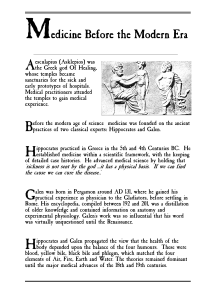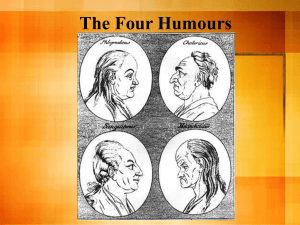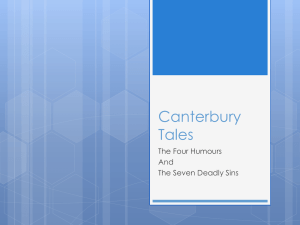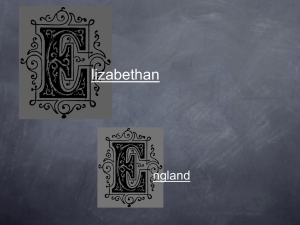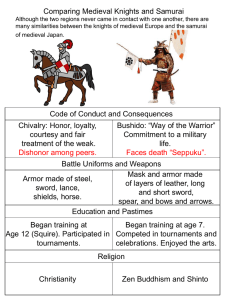Health in Medieval Times - The Martyrs of Amersham
advertisement
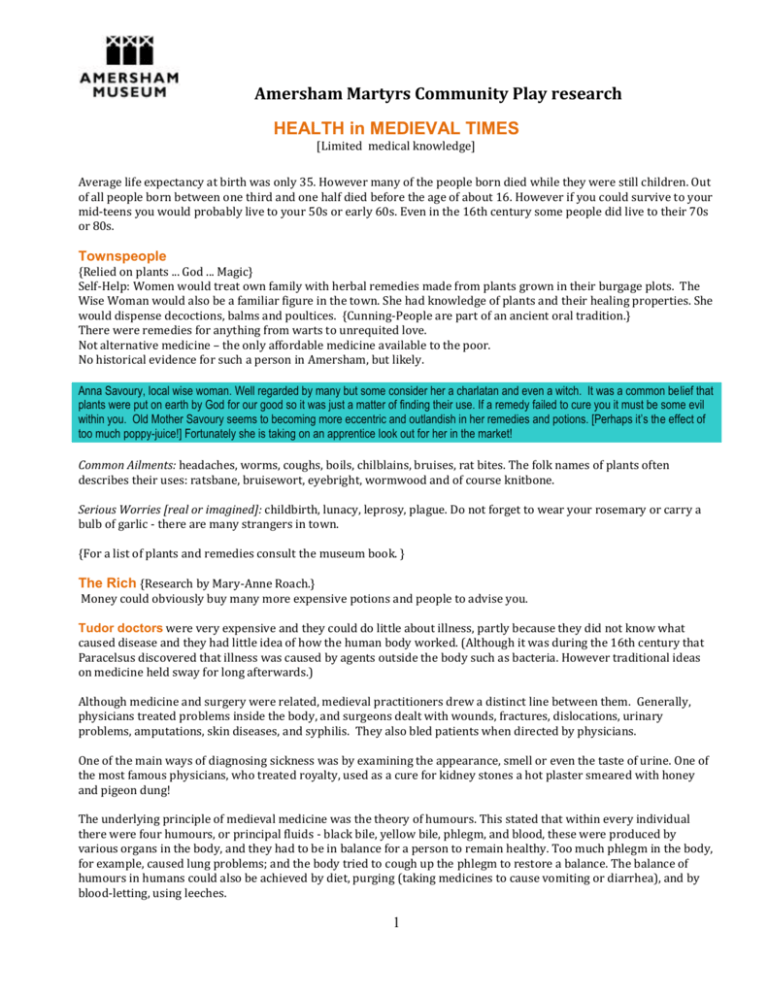
Amersham Martyrs Community Play research
HEALTH in MEDIEVAL TIMES
[Limited medical knowledge]
Average life expectancy at birth was only 35. However many of the people born died while they were still children. Out
of all people born between one third and one half died before the age of about 16. However if you could survive to your
mid-teens you would probably live to your 50s or early 60s. Even in the 16th century some people did live to their 70s
or 80s.
Townspeople
{Relied on plants ... God ... Magic}
Self-Help: Women would treat own family with herbal remedies made from plants grown in their burgage plots. The
Wise Woman would also be a familiar figure in the town. She had knowledge of plants and their healing properties. She
would dispense decoctions, balms and poultices. {Cunning-People are part of an ancient oral tradition.}
There were remedies for anything from warts to unrequited love.
Not alternative medicine – the only affordable medicine available to the poor.
No historical evidence for such a person in Amersham, but likely.
Anna Savoury, local wise woman. Well regarded by many but some consider her a charlatan and even a witch. It was a common belief that
plants were put on earth by God for our good so it was just a matter of finding their use. If a remedy failed to cure you it must be some evil
within you. Old Mother Savoury seems to becoming more eccentric and outlandish in her remedies and potions. [Perhaps it’s the effect of
too much poppy-juice!] Fortunately she is taking on an apprentice look out for her in the market!
Common Ailments: headaches, worms, coughs, boils, chilblains, bruises, rat bites. The folk names of plants often
describes their uses: ratsbane, bruisewort, eyebright, wormwood and of course knitbone.
Serious Worries [real or imagined]: childbirth, lunacy, leprosy, plague. Do not forget to wear your rosemary or carry a
bulb of garlic - there are many strangers in town.
{For a list of plants and remedies consult the museum book. }
The Rich {Research by Mary-Anne Roach.}
Money could obviously buy many more expensive potions and people to advise you.
Tudor doctors were very expensive and they could do little about illness, partly because they did not know what
caused disease and they had little idea of how the human body worked. (Although it was during the 16th century that
Paracelsus discovered that illness was caused by agents outside the body such as bacteria. However traditional ideas
on medicine held sway for long afterwards.)
Although medicine and surgery were related, medieval practitioners drew a distinct line between them. Generally,
physicians treated problems inside the body, and surgeons dealt with wounds, fractures, dislocations, urinary
problems, amputations, skin diseases, and syphilis. They also bled patients when directed by physicians.
One of the main ways of diagnosing sickness was by examining the appearance, smell or even the taste of urine. One of
the most famous physicians, who treated royalty, used as a cure for kidney stones a hot plaster smeared with honey
and pigeon dung!
The underlying principle of medieval medicine was the theory of humours. This stated that within every individual
there were four humours, or principal fluids - black bile, yellow bile, phlegm, and blood, these were produced by
various organs in the body, and they had to be in balance for a person to remain healthy. Too much phlegm in the body,
for example, caused lung problems; and the body tried to cough up the phlegm to restore a balance. The balance of
humours in humans could also be achieved by diet, purging (taking medicines to cause vomiting or diarrhea), and by
blood-letting, using leeches.
1
The four humours were also associated with the four seasons, black bile - autumn, yellow bile - summer, phlegm winter and blood - spring.
Humour
Black bile
Phlegm
Blood
Yellow bile
Temper
Melancholic
Phlegmatic
Sanguine
Choleric
Organ
Spleen
Lungs
Head
Gall Bladder
Nature
Cold Dry
Cold Wet
Warm Wet
Warm Dry
Element
Earth
Water
Air
Fire
Doctors also thought infectious disease, like plague, were caused by poisonous 'vapours', which drifted through the air
and were absorbed through the skin.
Astrology also played a part in Tudor medicine. Most doctors believed that different zodiacal signs ruled different parts
of the body.
The use of herbs dovetailed naturally with this system, the success of herbal remedies being ascribed to their action
upon the humours within the body. The use of herbs also drew upon the medieval Christian doctrine of signatures
which stated that God had provided some form of alleviation for every ill, and that these things, be they animal,
vegetable or mineral, carried a mark or a signature upon them that gave an indication of their usefulness. For example,
the seeds of skullcap (used as a headache remedy) can appear to look like miniature skulls; and the white spotted
leaves of Lungwort (used for tuberculosis) bear a similarity to the lungs of a diseased patient.
In the medieval period the term hospital encompassed hostels for travelers, dispensaries for poor relief, clinics and
surgeries for the injured, and homes for the blind, lame, elderly, and mentally ill.
In the 16th century many people died in epidemics of sweating sickness (possibly influenza). Many others died of
smallpox. (Later, Queen Elizabeth I almost died of it. However she was given the most advanced medical treatment for
smallpox - she was wrapped in red cloth.) Even if you survived smallpox it could leave you disfigured with pox marks
or blind.
Syphilis was also rampant. The standard treatment was mercury administered with a urethral syringe. Dysentery was
also a killer; many women died in childbirth (usually because of infection).
There was always concern that The Black Death might strike again as it had in the 1300s when it killed ⅔rds of
England’s population. (In Bubonic Plague, lung lesions occur, heart and kidneys turn into fatty goo, and death may
occur from heart failure. The walls of blood vessels are attacked frequently causing hemorrhages and acute blood
poisoning. It is fatal in almost all cases. It was transmitted via inhalation, ingestion, or even slight abrasion of skin.)
The name “leprosy” was given to many disfiguring diseases. In cases of disfigurement it was not the actual educated
doctors who would diagnose a patient, but rather it would be the priests or even the common people who would do so.
Lepers were usually banned to leper hospitals or leper communities. In many cases, leper hospitals housed as well the
poor and other sick, who were not fearful enough of leprosy but hungry enough to risk infection.
Surgeons and Surgeon Barbers
Actual operations were performed by a barber-surgeon. He was the barber, the surgeon and the dentist combined.
Barber-surgeons had lower status than doctors.
Tudor surgeons had opium and hemlock as anaesthetics – but both of them were very dangerous because the wrong
dose could kill and Tudor doctors had only a vague idea about correct dosages. Many surgeons refused to use these
substances because they were too dangerous.
Operations could end in death as post-operative infections were common. Instruments used in an operation were not
sterilised - as there was no knowledge of germs, there was no need to clean instruments used in operations. Patients
might recover from small operations, such as a tooth extraction (though this could not be guaranteed), but operations
that included a deep cut through the skin were very dangerous.
Apothecaries
Lower still were the apothecaries who made up medicines. The medieval apothecaries were individuals selling wine,
spices and herbs. They prepared and sold medicines to physicians and directly to patients. In addition, they offered
medical advice and other products. They were originally part of the grocery business.
2
Wealthy women
Wealthy women thought it their duty to tend herb gardens and make remedies to heal sick. These were recorded in a
Common Place Book.
If an Apothecary visited the fair - what conflicts might arise with Mother Savoury?
{All the above information was obtained from a LADY! - perhaps she will be at the market and be able to inform us about the budget the
Duke of Buckingham puts by for Spicery!]
Some other cures:
Toothache: burn a candle close to the tooth. The worms that are gnawing the tooth will fall out into a cup of water held
by the mouth.
Evil spirits in the head: For this, surgeons used trepanning. This was where a surgeon cut a hole into the skull to release
evil spirits trapped in the brain. The operation might also include cutting out the part of the brain that had been
‘infected’ with these evil spirits.
Headache and aching joints: head pains were treated with sweet-smelling herbs such as rose, lavender, sage, and bay. A
mixture of henbane and hemlock were applied to aching joints. Coriander was used to reduce a fever.
Stomach pains and sickness: treated with wormwood, mint, and balm.
Lung problems: a medicine made of liquorice and comfrey. Horehound cough syrups and drinks were prescribed for
chesty and head-colds and coughs.
Wounds: wounds were cleaned and vinegar was widely used as a cleansing agent as it was believed that it would kill
disease. Mint was also used in treating venom and wounds. Myrrh was used as an antiseptic on wounds.
The Church
The health of the Soul was more important than your Body! Illnesses were sent as a punishment for our sins. Christ
was your Physician. [If you repented you could be healed. Hence the importance of Pilgrimages – Prayer- Penance.]
Monks planted Healing-Gardens. They tended their wort beds and looked after the sick. Any plant ending in wort were
grown and used by the monks. The Benedictine order of monks regarded the care of the sick there chief act of mercy
despite some Christians thinking the medical profession not a suitable occupation.
The activities of Mother Savoury were condemned and considered to be works of the devil.
Perhaps the Monks from Missenden Abbey were not just drunk on our streets but gave help to the sick and sanctuary in their Pest House?
3
